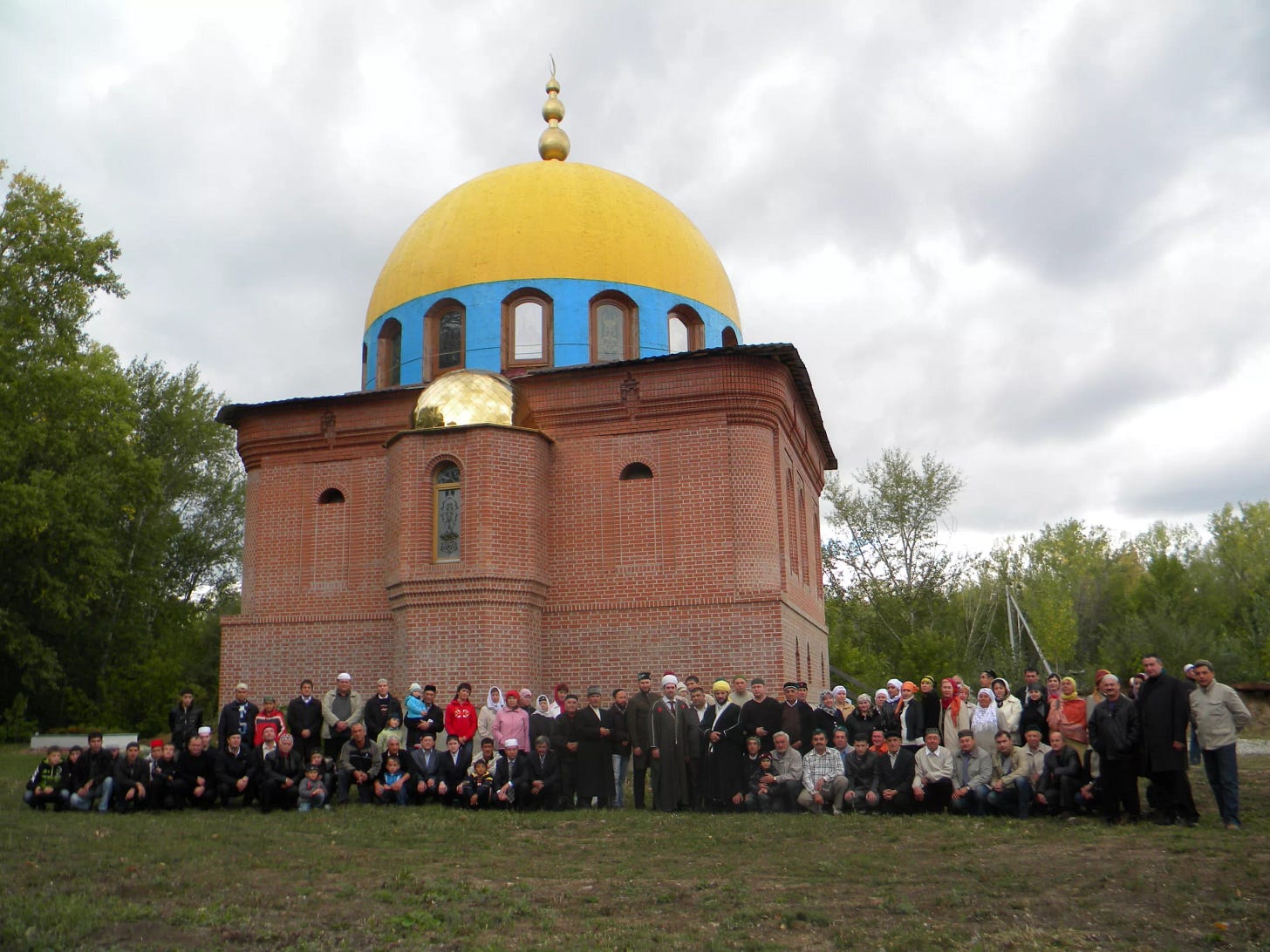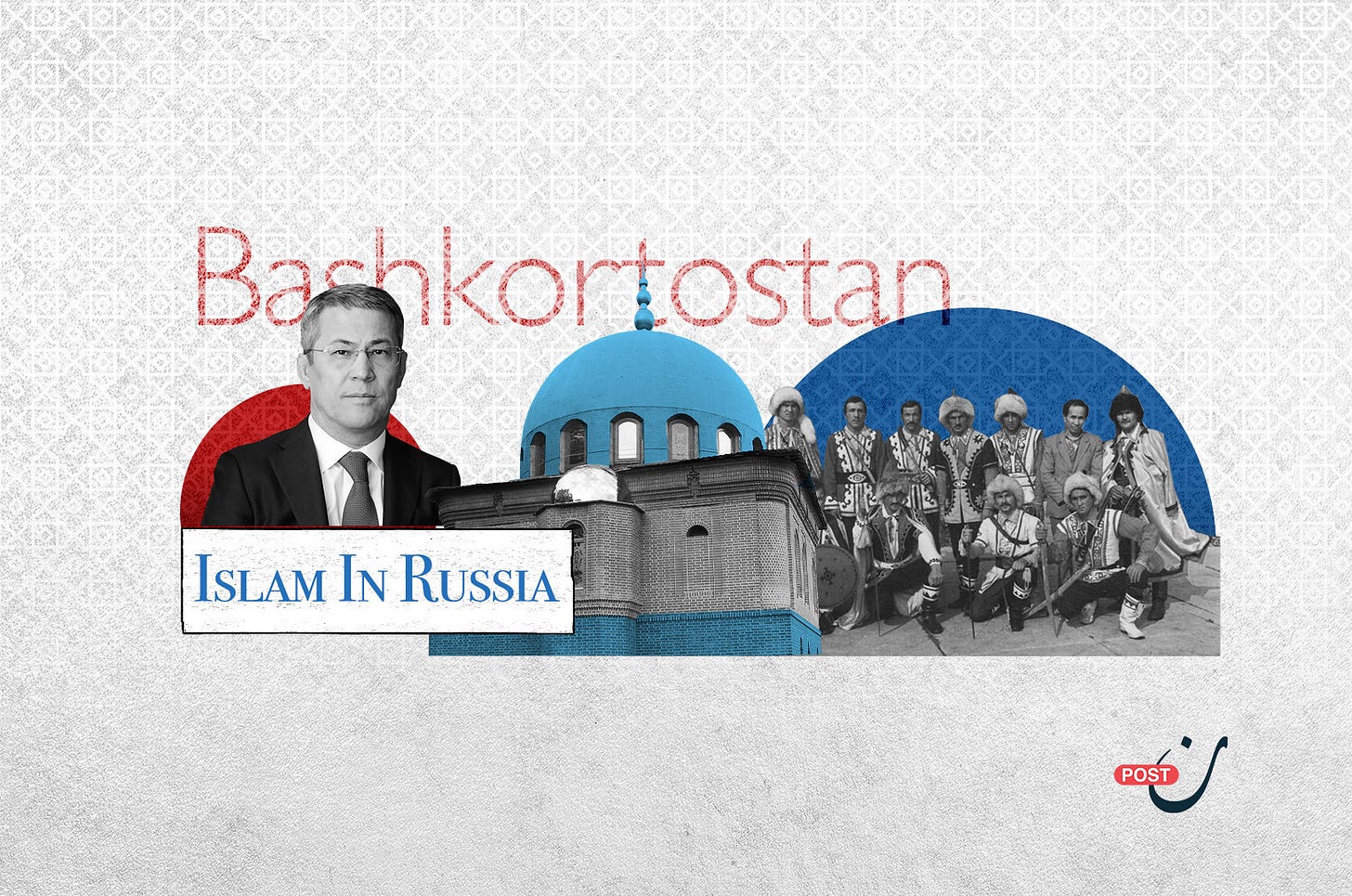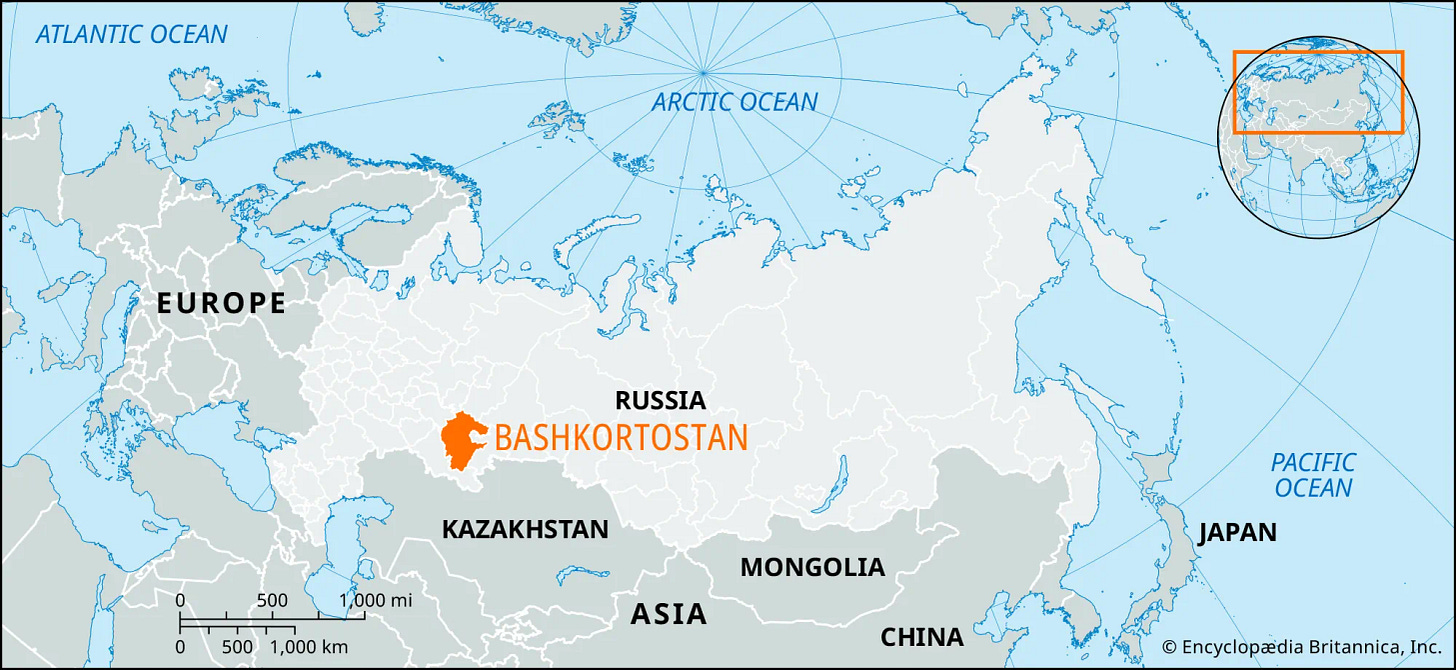Nestled 1,100 kilometers east of Moscow, the Republic of Bashkortostan—known in Russian as Bashkiriya—lies between the banks of the Volga River and the slopes of the Ural Mountains, which bridge Europe and Asia.
It shares borders with Perm Krai to the north, Sverdlovsk Oblast to the northeast, Chelyabinsk Oblast to the east and southeast, Orenburg Oblast to the south and southwest, and the republics of Tatarstan and Udmurtia to the west and northwest respectively.
The name Bashkortostan derives from its indigenous people, the Bashkirs, with the Persian suffix “-stan” meaning “land” or “state”—a linguistic testament to the Bashkirs’ historical claim to the region. Ironically, however, the Bashkirs are not the majority ethnic group in the republic that bears their name; about 60% live within Bashkortostan, while the rest are spread across neighboring regions.
As part of our series “Lands of Islam in Russia,” we delve into the history and identity of this region—alongside Siberia and the North Caucasus republics of Chechnya, Ingushetia, Dagestan, Kabardino-Balkaria, Karachay-Cherkessia, as well as Tatarstan and Bashkortostan—home to Russia’s estimated 25 million Muslims.
A Historical and Religious Snapshot of the Bashkirs
Spanning 142,900 square kilometers, Bashkortostan is home to more than 100 ethnic groups. According to the 2024 census, it has a population of over 4.5 million: 37% Russian, 31% Bashkir, 24% Tatar, followed by smaller communities like the Chuvash, Mari, Ukrainians, and Udmurts.
The Bashkirs preserve a rich cultural heritage, and despite modern pressures, many traditions and crafts still survive, though they are fading fast. The two dominant religions in Bashkortostan are Islam (67%) and Orthodox Christianity (22%). Most Bashkirs and Tatars adhere to the Hanafi school of Sunni Islam.
The Bashkir language, a member of the Turkic language family, was once written in Arabic and Latin scripts before the Cyrillic alphabet was imposed by Soviet authorities in 1939.

Bashkirs and Tatars are closely related linguistically, culturally, and religiously. Yet today, tensions exist—rooted in Stalin’s deliberate territorial division to weaken both groups and consolidate Moscow’s control.
Although more than half the population is Muslim, secularism predominates in Bashkortostan (and Tatarstan), unlike the more overtly religious Chechnya or Dagestan. Still, many Bashkirs remain deeply devout.
The Bashkirs are part of the vast Turkic world, stretching from the Baltic and Black Seas to the Pacific and from the Caucasus to the Himalayas. They have inhabited this land for millennia.
The Bashkirs’ presence dates back to the 7th century, when they were part of Volga Bulgaria, coexisting with Tatars, Bulgars, and other groups. Persian scholar Abu Zayd al-Balkhi described the Bashkirs as an independent nation split into two groups—one on either side of the Urals, near the Volga and near the Byzantine frontier.
In the 10th century, Ahmad ibn Fadlan, envoy of the Abbasid Caliph in Baghdad, documented his journey through Bashkir territory en route to Volga Bulgaria. He described the Bashkirs as strong, warlike pastoralists inhabiting the southern Urals and Volga regions.
According to his account, the Bashkirs worshipped 12 deities, including gods of sky, earth, rain, horses, night, and death—with the sky god as their supreme deity.
A century later, renowned geographer Yaqut al-Hamawi (1179–1229) encountered Bashkir students in Aleppo studying Islam, who explained that their community embraced Islam after Volga Bulgaria adopted it as a state religion in 922. Much of western Bashkir territory was then part of Bulgaria.
These accounts suggest the Bashkirs were early adopters of Islam and among the first nomadic groups to cultivate their own Islamic scholars.
After resisting the Mongols for 14 years, the Bashkir lands fell to Mongol control in 1236. By 1294, following the fragmentation of the Mongol Empire, they came under the Golden Horde, which embraced Islam soon after. Scholar Allen J. Frank notes that Islam spread more widely among Bashkirs after this transition.
Bashkir oral tradition holds that Sufi mystics from Central Asia, Baghdad, and Anatolia played a key role in spreading Islam among them. Given their proximity to strong Islamic states and Central Asian Muslims, this was no surprise.
A Russian Colony
After the Golden Horde collapsed in the 14th century, Bashkir lands came under the Khanates of Kazan, Sibir, Astrakhan, and the Nogai Horde. The Bashkirs lacked a centralized government and were instead divided into at least 30 tribes.
When Ivan the Terrible captured Kazan in 1552, Russian expansion reached the Urals. Although the Bashkirs mounted fierce resistance, Russian forces began seizing their territory by 1557.
According to the Russian narrative, Bashkir representatives voluntarily submitted to Tsar Ivan IV in 1557. However, many historians argue this was a conquest, not a union. Bashkir historian Zinurov details a five-year war waged by Bashkir tribes against Russia, disputing the idea of voluntary integration.
In truth, resistance persisted for two centuries. Western Bashkirs succumbed to Russian control in the 1550s, while eastern tribes weren’t fully subdued until the 1620s after bloody campaigns. Following the devastating Russo-Bashkir wars of 1704–1735, the Russian state asserted total control by the 1750s, building border fortresses and restricting Bashkir movement.
Moscow imposed increasing taxes, Orthodox conversion, and Russification. Russian settlers moved in, altering the region's demography. By the early 19th century, the Bashkirs had become a minority on their ancestral land. In 1881, the tsarist government split their territory between Ufa and Orenburg—only the former remained within Bashkiria.
The Collapse of Independence
After the fall of the Russian Empire in 1917, Bashkir leaders declared independence and sought union with the Tatars in a short-lived state called “Idel-Ural.” In December 1917, the Bashkir Constituent Assembly unanimously voted for independence.
Moscow rejected this outright. Admiral Kolchak opposed Bashkir autonomy, and soon, the Bolsheviks invaded. In 1919, they created a puppet entity known as “Lesser Bashkiria,” which angered many. In 1922, they redrew borders to include Ufa—bringing in more Russians and reducing Bashkir majority status.
The Bashkirs revolted several times against Soviet rule, opposing its repressive policies, forced secularization, mass executions, mosque closures, and religious school bans.
After the USSR collapsed, Bashkortostan’s national movement reawakened. In October 1990, it declared sovereignty, and by 1993, signed agreements with Moscow that granted it autonomy over natural resources, taxation, and limited foreign relations.
Moscow’s Treasure Chest
Bashkortostan is one of Russia’s richest regions, dubbed the “second Switzerland” for its natural beauty. It boasts over 13,000 rivers, 7,900 lakes and reservoirs, and vast oil, gas, gold, and mineral reserves.
Despite a diverse economy—including thriving tourism and agriculture sectors—its industrial might, particularly in fuel and energy, remains dominant. Bashkortostan ranks first among Russian regions in producing meat, honey, milk, and horses.
Still, most of its wealth flows to Moscow. Major companies are Russian-owned, and Bashkirs reap little benefit. Wages are 26% lower than the Russian average, and poverty drives many young men to enlist in the military—explaining why Bashkortostan, despite being only 2.1% of Russia’s population, has the fourth-highest casualty rate in the Ukraine war.
Putin’s long-term strategy has been to re-centralize power and erode non-Russian identities. This has included rewriting history, removing native languages from schools, weakening national organizations, and suppressing dissent.
In 2007, Bashkortostan lost the right to publish its own textbooks without Moscow’s approval. Celebrating national heroes or discussing uprisings was banned. In 2018, Russian law made Bashkir and other minority languages optional, with final exams only available in Russian—further undermining Bashkir identity.
Students, prioritizing careers, naturally choose Russian. Former Deputy Education Minister Ildar Itkulov warned of the collapse of Bashkir-language schooling, especially in rural areas.
Alongside cultural and linguistic demands, Bashkirs launched several social and environmental movements, including the now-banned “Bashkort” group, targeted for alleged extremism in 2020.
Today, Bashkirs face systemic marginalization, forced assimilation, mass arrests, media suppression, and harsh crackdowns on dissent and antiwar voices.
In early 2024, social and economic grievances sparked mass protests. Russian security forces responded swiftly. According to sociologist Guzel Yusupov, the protests weren’t driven by nationalism but were a response to injustice and corruption. Bashkortostan’s disproportionate war casualties fueled anger: poor Bashkirs were overrepresented in Moscow’s military.
As Russia increasingly relies on non-Russian regions for military recruitment, many see the Ukraine war as a form of ethnic cleansing—leading desperate Bashkirs to torch military recruitment offices.
Over the past three decades, Bashkortostan has seen every promise of autonomy and prosperity revoked. Under Putin, centralized control, economic exploitation, and cultural suppression have only deepened Bashkir alienation.






